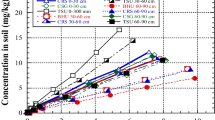Summary
The variable effects, previously observed under field and laboratory conditions, resulting from the application of the widely used chlorinated hydrocarbon insecticides has stimulated further investigations. Because of the possible cumulative harmful effects of the insecticides on the activities of soil micro-organisms, several investigations have been concerned with the influence of these insecticides on the conversion of ammonia to nitrate.
The present investigation is concerned with the relationship between the deleterious effect of certain pesticides on the activities of the soil microflora and the use of nitrogenous fertilizers; an aspect of the problem which has not previously been considered.
The results of the investigation may allow the anomalous effects of the insecticides in the laboratory and in the field to be understood.
The observations indicate that the basis of the effects of hexachlorocyclohexane on soils is as an inhibitor of nitrification.
Similar content being viewed by others
References
Alexander, M., Nitrification in Soil Nitrogen, Bartholomew, W. V., and Clark, F. E. editors, American Society of Agronomy, p. 307 to 343 (1965).
Bardiya, M. C. and Gaur, A. C., Effect of some chlorinated hydrocarbon insecticides on nitrification in soil. Z. Bacteriol. II 124, 552–555 (1970).
Black, A. C., Soil-Plant Relationships. John Wiley and Sons, Inc. New York, (1967).
Brown, A. C., Effect of several insecticides on ammonification and nitrification in two neutral alluvial soils. Soil Sci. Soc. Am. Proc. 18, 417–420 (1954).
Eno, C. F. and Everett, P. H., Effects of soil microorganisms and the growth of stringless black valentine beans Soil Sci. Soc. Am. Proc. 22, 235–238 (1958).
Fletcher, D. W., and Bollen, W. B., The effects of aldrin on soil micro-organisms and some of their activities related to soil fertility. Applied Microbiol. 2, 349–354 (1954).
Goring, C. A. I., Control of nitrification by 2-chloro-6 (trichloromethyl) pyridine. Soil Sci. 93, 211–218 (1962).
Horn, G. C., The effect of certain insecticides on the flora of Arredondo fine sand. Soil Sci. Soc. Florida Proc. 12, 62–67 (1952).
Jones, L. W., Effect of some pesticides on microbial activity of the soil. Utah Agr. Expt. Sta. Bull. 390, 17–29 (1956).
Lakocy, A., The effect of chlordane and HCH on crop yields. Roczn. Nauk. Rol. 74A, 460–466 (1957).
Mahmoud, S. A. Z., Selim, K. G., and El Mokhadem, M. T., Effect of Dieldrin and Lindane on soil microorganisms. Z. Bakteriol. II 125, 134–149 (1970).
Morrison, H. E., Crowell, H. H., Crumb, S. E.jr., and Lauderdale, R. W., The effect of certain new soil insecticides on plants J. Econ. Entomol. 41, 374–378 (1948).
Prince, A. L., Determination of total nitrogen, ammonia, nitrates, and nitrites in soils. Soil Sci. 59, 47–52 (1945).
Ross, H. F., Effects of DDT, chlordane and aldrin on nitrification and ammonification in Arredondo fine sand. Soil Sci. Soc. Florida Proc. 12, 58–61 (1962).
Shaw, W. M., and Robinson, B., Pesticide effects in soil on nitrification and plant growth. Soil Sci. 90, 320–323 (1960).
Singh, H., and Metha, V. S., Study on the effect of chlorinated insecticides on nitrification of alluvial soils of Gwalior. Allahabad Farmer 38, 269–271 (1964). From Soil and Fertilizers 29 nr. 1088 (1966).
Smith, N. R. and Wenzel, M. E., Soil microorganisms are affected by some of the new insecticides. Soil Sci. Soc. Am. Proc. 12, 227–233 (1947).
Verona, O., On the effect of hexachlorocyclohexane on the soil microflora. Ann. Tec. Agr. 17, 9–17 (1951).
Verotraeten, L. M. J., Vlassak, K., and Livens, J. Water-soluble carbon and nitrogen in soil and their relation to land use and texture. Soil Sci. 113, 200–203 (1972).
Vlassak, K., Invloed van organische stoffen op de mineralisatie van stikstof in kultuurland. Agricultura 10, 481–511 (1962).
Vlassak, K., Verstraeten, L. M. J., and Livens, J., Distribution of forms of nitrogen and carbon in some soil profiles. 1. Soil Sci. 108, 127–131 (1969).
Wegorek, W., The effect of HCH preparations and chlordane on plants and soil microflora. Roczn. Nauk. Rol. 74A, 373–392 (1957).
Author information
Authors and Affiliations
Rights and permissions
About this article
Cite this article
Verstraeten, L.M.J., Vlassak, K. The influence of some chlorinated hydrocarbon insecticides on the mineralization of N fertilizers and plant growth. Plant Soil 39, 15–28 (1973). https://doi.org/10.1007/BF00018041
Received:
Issue Date:
DOI: https://doi.org/10.1007/BF00018041




